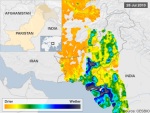Please note that this article is not a final report or concluding research on the subject, but instead combination of possible factors that may have contributed to the severe July 2010 flooding in Pakistan. All scientific statements contains a valid references. Hence, the article must not be confused with the actual findings from the Meteorological Department findings. In mid August, many respected scientifc sources such as New Sicentist, Scientific American, NASA, or BBC discussed this issue in depth lying down some possibilities as well as satellite results. I have mentioned some of the results from these studies, with my comments.I will surely update the post and try to put some authenticate results with the permission of the owners once I have the access to them.
In late July 2010, flooding caused by heavy monsoon rains began across several regions of Pakistan. According to the Associated Press, the floods have affected about one-fifth of this country of more than 170 million. Between July 28 and 29, up to 400 millimeters (16 inches) of rain fell from these storm cells, triggering flooding along the Indus and Kabul Rivers. Storms with similar structures to this one have become common this summer as tropical monsoon moisture, coupled with a strengthening La Nina (which has different effects around the world), dominate this region’s weather patterns.
[Source: NASA]
The above figures are obtained by NASA’s CloudSat satellite. As seen in the top half of the bottom image, CloudSat classified the majority of the clouds present at the time as deep convective (cumulonimbus) clouds, which are typical of thunderstorms. The bottom half of the lower image shows the 3-D vertical structure of the storm along the satellite’s flight path, revealing its heavy precipitation. As CloudSat’s Cloud Profiling Radar passed over the area of heaviest precipitation, its signal thinned significantly. By the middle of the image, the ground echo (horizontal red line), which represents the topography of the area, completely disappears. The thinning of the radar’s signal occurs because larger-sized particles and heavy rains decrease radar reflectivity and become indistinguishable to the radar. As the satellite continued traveling north, rainfall rates decreased and the signal increased, allowing the ground echo (topography) to once again become visible, at the far right of the image. CloudSat measured the height of the clouds along the radar’s flight path at around 15 kilometers (9.3 miles) in the areas of deepest convection.
Storms with similar structure to this one have become common this summer as tropical monsoon moisture, coupled with a strengthening La Nina, dominate this region’s weather patterns.
BBC Science department also presented results from SMOS satellite. SMOS satellite has revealed the results based on the observation made from 17th July to 4th August. Four snapshots (obtained on courtesy of CESBIO/BBC) reveals the damage done, which off-course is much more severe now.
Satellite data is frequently used in the relief response to major disasters, and in the case of Pakistan the world’s satellite fleets were mobilised on 2 August to provide space-borne information under the International Charter [on] Space and Disasters. The severity in the floods is apparent from the above set of figures, showing the ground getting progressively wetter, highlighted by transition from yellow/orange to blue/gray region.
Dr Claire Gruhier, France based Smos researcher, told BBC News the results were preliminary: “What we show is not the flood area; what we show is the water content in the soil. So, it is not exactly the same information. But our maps are very consistent with the flood-affected areas in Pakistan revealed by other satellites.” According to the sources, the SMOS team is confident that once the data obtained is validated and algorithms fine tunes, the team will be able to infer also the extent of actual floods.
SMOS – Soil Moisture and Ocean Salinity (SMOS) mission
ESA’s project for Soil Moisture and Ocean Salinity (SMOS) mission, which has been designed to to observe soil moisture over the earth’s landmasses and salinity over oceans. These analysis are important for hydrological studies and to gain better understanding of ocean circulation patterns. Moreover, the mission will also contribute to further understanding of Earth’s water cycle. Launched on 2 November 2009, SMOS is the second Earth Explorer Opportunity mission to be developed as part of ESA’s Living Planet Programme.
This data is particularly useful for extreme weather forecast predictions as well as to pick up seasonal climate changes within the defined region. An important aspect of this mission is that it will demonstrate a new measuring technique by adopting a completely different approach in the field of observing the Earth from space. A novel instrument has been developed that is capable of observing both soil moisture and ocean salinity by capturing images of emitted microwave radiation around the frequency of 1.4 GHz (L-band). SMOS will carry the first-ever, polar-orbiting, space-borne, 2-D interferometric radiometer.
Why is it important to observe soil moisture ?
Simply because it plays an important role in the global water cycle. However, in-situ measurements of soil moisture are sparse but, if we are to better our understanding of the water cycle so that the forecasting of climate, weather and extreme-events can improved, more data are urgently required.The same is true for data on ocean salinity. There are few historical measurement data, and only a small fraction of the ocean is currently sampled on any regular basis. Salinity and temperature determine the density of seawater, and in turn density is an important factor driving the currents in our oceans. Ocean circulation plays a crucial role in moderating the climate by, for example, transporting heat from the Equator to the poles. Ocean salinity is therefore one of the key variables for monitoring and modelling ocean circulation.
Based on Scientific American Observation, Although Global Warming or adverse climate changes can be blamed for the floods in Pakistan, but some sources believe that A major factor that led to the massive flooding is illegal logging in the northwest province of Khyber-Pakhtunkhwa. In forestry terms, illegal logging is simply a timber theft. Illegal logging is a pervasive problem, causing enormous damage not only to forests, but also to local communities. This contributes to deforestation, and by extension global warming. These illegal activities undermine responsible forest management, encourage corruption and tax evasion and reduce the income of the producer countries, further limiting the resources producer countries can invest in sustainable development.
This argument further justified by Jamshed Ali, Secretary-General of Sarhad Awami Forestry Ittehad (SAFI),an organisation meant to protect forests in the province, Ali, said in parts of Malakand district more than 70 per cent of forests had been felled by a well-connected “timber mafia” that was difficult to stop. The blame was indeed put on Talibans by Mr Ali.
Human Failure Again ?
According to the article published Scientific American, more statements followed by many respected sources of Pakistan, Over-grazing by livestock — common in rural Pakistan — can also remove layers of topsoil and stunt plant growth, reducing the soil’s ability to hold water, said Asad Jarwar Qureshi of the International Water Management Institute. And more, Abdul Qadir Rafiq of the United Nations Development Programme says without vital topsoil, flash-flooding in northern, mountainous areas can result, sending silt downstream which then reduces the amount of water the river channel can hold. “We need to clear the river channels of silt every four to five years and stop people living within a kilometre of the river channel. There are irrigation channels built using techniques from the 18th century. We need to react to the present-day,” Qureshi said.
Off-course, all of the above statements, can be further challenged by blaming everything on extreme weather patterns, which has always played its part. But the nation has to realize, a potential threat and must learn to act in her favor. But it must be evident that, though there exist the chances of illegal logging or overgrazing in the corrupt society like this exists, particularly In the militant-infested Swat region, as Secretary-General of Sarhad Awami Forestry Ittehad (SAFI) has said, but these are not the only reasons. To my opinion, the Climate Change does play an important role with an appropriate river management techniques, which unfortunately have always been ignored.
Source: Climate Change, Human Failing behind Pakistan Floods, By Rebecca Conway (Scientific American Aug 31, 2010)
Combination of strong polar jet stream with usual monsoon in Pakistan, to cause unusually intense flooding.
Then, having taken up such an unusual position, the jet stream just sat there, frozen in place. The weather systems causing the heatwave and the torrential rains remained in place for more than a month, continuing to contribute to the increasingly disastrous conditions. The reason for such unusual condition aren’t clear yet, but it is believed that human-induced climate change has increased the certainty of severe heat waves.
Based on the Pakistan’s Meteorological Dept, it was suggest earlier July (in a usual monsoon update) that strong tropospheric winds are expected. Based on the observations made in June 2010, due to high sea-land temperature contrast the development of some mid-tropospheric circulations were likely (particularly over Sindh region). Moreover, in same observation report prediction of a very heavy rainfall events were made over northern region of the country. This is due the interactions of westerly-easterly waves (so called jet stream). The report was made with 80% of confidence level, which suggests that alarm was made well in advance. But still no precautions were actioned by the government. Whether this is lack of communication or laziness of the government, the damage has been done and its seriousness is clear enough.
What are Jet streams and why are they so important ?
In very simple words, the jet stream is a current of fast moving air found in the upper levels of the atmosphere (troposphere 10-16 km) above earth surface. The position of this upper-level jet stream denotes the location of the strongest surface temperature contrast
Usually in summer, these waves are weaker, primarily because of less dramatic surface temperature changes. These waves and their strength is evident in figure above, with jet streaks, shown in red. Latter are localized regions of very fast winds embedded within the jet stream. Sometimes these local wind maxima reach speeds in excess of 160 knots. As air enters a jet streak, it speeds up. When it leaves a jet streak, it slows down. These accelerations and decelerations, coupled with the curvature of the jet stream and strong wind shears, cause air to pile up in some areas (convergence) and spread out (divergence) in others. These regions of divergence and convergence have a significant influence on surface pressure features.
Bypassing complex scientific principles, a simple physics can tell us a much about what we can expect. Generally warmer temperatures imply more extremes high temperatures. Second, warmer air holds more moisture, meaning that we can expect higher peak rainfall rate and daily totals, locally and regionally, from both convection (thunderstorms) and larger-scale weather systems, where air is forced to rise and cool in clouds, condensing its water vapour and creating rain.
Moreover, Possible changes in regional weather patterns will mean that an individual region may see substantially larger changes (both negative and positive) than those implied by the globally averaged change. As I have mentioned earlier, that saying that current flooding is purely due to climate change is difficult. Though, by knowing the Arabian sea temperature, the above argument can either be accepted or rejected. This means that if the sea temperature is cool enough, than above warm air holding water argument can be eliminated, but that may not be the case.
It is the position of the Jet stream, Low pressure weather, depressions (cause heavy rain), duration of this weather is also concern, Why these waves remain there, don’t know ? Many believed linked with La Nina
La Nina occurs when cool water surges up from the bottom of the ocean (Pacific). The water cools the air above it, setting off a series of changes in the Earth’s atmospheric circulation.
Frozen jet stream links Pakistan floods
According to meteorologists monitoring the atmosphere above the northern hemisphere, unusual holding patterns in the jet stream are to blame. As a result, weather systems sat still.Temperatures rocketed and rainfall reached extremes.The notice in the usual pattern of these waves have been observed, the waves normally shift east, dragging weather systems along with it. But in mid-July they ground to a halt, say Mike Blackburn of the University of Reading, UK.
Stationary patterns in the jet stream are called “blocking events”. They are the consequence of strong Rossby waves, which push westward against the flow of the jet stream. They are normally overpowered by the jet stream’s eastward flow, but they can match it if they get strong enough.A static jet stream freezes in place the weather systems that sit inside the peaks and troughs of its meanders. Warm air to the south of the jet stream gets sucked north into the “peaks”. The “troughs” on the other hand, draw in cold, low-pressure air from the north. Normally, these systems are constantly on the move – but not during a blocking event.And so it was that Pakistan fell victim to torrents of rain. The blocking event coincided with the summer monsoon, bringing down additional rain on the mountains to the north of the country.
According to the source [OptimumPopulation.Org];
Similarly, as the static jet stream snaked north over Russia, it pulled in a constant stream of hot air from Africa. The resulting heatwave is responsible for extensive drought and nearly 800 wildfires at the latest count. The same effect is probably responsible for the heatwave in Japan, which killed over 60 people in late July. At the same time, the blocking event put an end to unusually warm weather in western Europe.
So what is the root cause of all of this? Meteorologists are unsure. Climate change models predict that rising greenhouse gas concentrations in the atmosphere will drive up the number of extreme heat events. Whether this is because greenhouse gas concentrations are linked to blocking events or because of some other mechanism entirely is impossible to say. Gerald Meehl of the National Center for Atmospheric Research in Boulder, Colorado – who has done much of this modelling himself – points out that the resolution in climate models is too low to reproduce atmospheric patterns like blocking events. So they cannot say anything about whether or not their frequency will change.
In the next post I will comment on the above points, and try to come up with the final possible points which may have led to this disaster. Many advanced nations, have developed the Disaster Management TEchniques, not only management but prevention as well. This was evident in 2007/08 UK’s flooding, which was recorded to be one of the worst in nation’s history. Of about 17,000 families forced from their homes in England, about 1,000 were still living upstairs or in temporary accommodation earlier this month. Although it is not possible to eliminate the risk of flooding completely, but it is indeed possible to learn from the mistakes and save as many lives as possible. From Pakistan’s recent experience it is evident that necessary measures has to be taken by the Government but also as citizens of Pakistan, since it is us, who are constantly in touch with the Environment.
[Sources:]
http://www.optimumpopulation.org/blog/?p=2711
http://www.wired.co.uk/news/archive/2010-08/16/jet-stream-kink
















